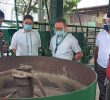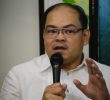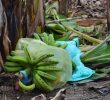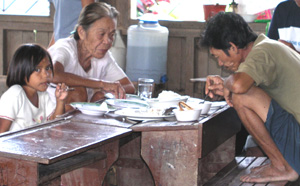 Medco�s Dureza says the SWS survey on hunger highlights the urgency of the government�s anti-poverty program. But Kadamay counters that unless the government stopped prioritizing foreign investments and business over the welfare of ordinary Filipinos, unless it stopped displacing families from their lands and unless it increased wages, rolled back oil prices and junked the E-VAT, poverty and hunger will persist.
Medco�s Dureza says the SWS survey on hunger highlights the urgency of the government�s anti-poverty program. But Kadamay counters that unless the government stopped prioritizing foreign investments and business over the welfare of ordinary Filipinos, unless it stopped displacing families from their lands and unless it increased wages, rolled back oil prices and junked the E-VAT, poverty and hunger will persist.
Related item
Rise in hunger incident blamed on denial of wage relief
DAVAO CITY (mindanaotoday.com) � Mindanao, the most abundant region in the country, which accounts for a third of the country�s food products and which produces key crops for export, has registered the highest incidence of hunger in the Philippines, according to the latest survey by the Social Weather Stations (SWS).
The survey, which also showed that hunger in the whole country registered a record increase, says 21 percent of respondent households in Mindanao experienced hunger, a slight decrease from the 21.7 percent registered in December 2005. The survey was done in the first quarter of this year and was released on Friday.
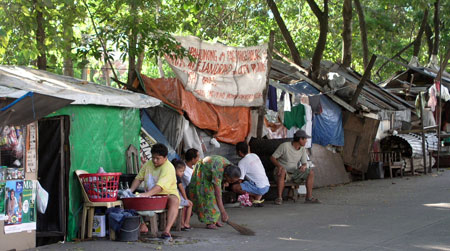
�The hunger trend in Mindanao has been very volatile,� the survey said. �In the past two years, it reached record-low of 5.3 percent in September 2003 and May 2005, and its highest point recorded at 23.0 percent in August 2004.�
Nationally, the SWS said the percentage of households �reporting having experienced hunger, with nothing to eat, at least once in the past three months,� reached a record high of 16.9 percent, which is equivalent to 2.8 million families. This surpassed the previous peak of 16.7 percent in December 2005, it said.
�The hunger trend has been rising since the end of 2003, upsetting a previous favorable trend when hunger steadily declined from a high 16.1 percent in March 2001 to the record-low 5.1 percent in September 2003,� the SWS said.
It said the hunger proportion has been at double-digits since the second quarter of 2004, with the latest figure of 16.9 percent raising the 1998-2006 average hunger-proportion from 10.6 percent to 10.8 percent.
�Severe hunger,� defined by the SWS as families going hungry �often� or �always� in the last three months, was at 4.2 percenet in March 2006, or almost 700,000 families.
�Moderate hunger,� defined as those experiencing it �once� or �a few times� in the last three months, was at 12.7 percent in March 2006, or about 2.1 million families.
Inday Duterte, spokesperson of Kadamay in Southern Mindanao, said the SWS survey only highlighted the government�s �flawed� and �anti-poor� economic policies in Mindanao, among them the push for agricultural products for exports, sacrificing domestic food production.
Production of consumer crops, such as rice and corn, has been declining over the years, although rice production increased by a measly 0.28 percent last year while corn production rose by 0.71 percent, according to the Mindanao Economic Development Council (Medco).
In contrast, major export crops registered double-digit increases last year: coffee, by 14.5 percent, banana by 13.4 percent, and mango, by 10.2 percent.
Despite the minimal growth, Medco pointed out last month, 30 percent of the country�s total agriculture value in 2005 came from Mindanao. Mindanao�s corn was 54.3 percent of the country�s total output, coffee 67.5 percent, banana 78 percent, coconut 59 percent, rubber 99.9 percent and pineapple, 85.7 percent.
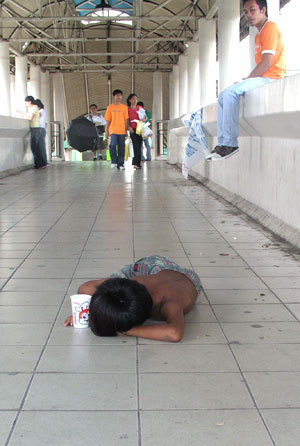 According to the Philippine government, poverty is mainly a rural phenomenon and is mainly agriculture-based. More than two-thirds of poor households live in the rural areas.
According to the Philippine government, poverty is mainly a rural phenomenon and is mainly agriculture-based. More than two-thirds of poor households live in the rural areas.
In a major policy speech in 2001, President Arroyo pointed out that, while agriculture-dependent households consist of only 40 percent of the total population, the sector accounts for two-thirds of the poor. Thus, she said, �our anti-poverty agenda has, as I mentioned earlier, one of its four main components the modernization of agriculture founded on social equity.�
But according to the Asian Development Bank, the Philippine economy�s reliance on agriculture has not been matched by efforts to protect it from what Thomas Crouch, the bank�s country director for the Philippines, called the �vagaries of nature.�
“Agriculture is very vulnerable sector, it�s dependent on the weather and that�s something that the government can�t control. However, it can look at opportunities to protect the sector like investing more in irrigation,” Crouch said.
Moreover, Crouch said, the economy has to become more robust so Filipinos can get out of the poverty trap. The economy grew 5.1 percent last year, a decline from the previous year�s 6.1 percent, due mainly to weak agricultural output and high oil prices, the bank said.
“If the growth continues at what it�s historically been in the last decade, it will not be sufficient to get the country out of the poverty trap,” Crouch said in February.
Meanwhile, Jesus Dureza, Medco�s chairman, told mindanaotoday.com, that the SWS was not surprising. �That has always been the profile of Mindanao,� he said. �Remember, six out of the 10 poorest provinces in the country are in Mindanao,� he pointed out, adding: �We don�t have to have the SWS tell us about hunger in Mindanao.�
Dureza said, though, that the SWS survey only emphasizes the importance of the government�s anti-poverty program. �The administration is focused on this program, especially in the conflict-affected areas,� he said. �The bigger framework of this program is to resolve conflict, peace and development, so we can create the enabling environment to eradicate hunger and poverty.�
He said the resolution of the Islamic separatist conflict, as well as the Communist insurgency, can create this �enabling environment.�
The government is negotiating with the Moro Islamic Liberation Front to end the decades-old Islamic movement in Mindanao. This week, the front and the government, who are doing the negotiations in Kuala Lumpur, announced �substantive gains� in the negotiations.
Dureza also said that �stop-gap measures� to address poverty and hunger are also in place. �We are doing this through the BIMP-Eaga by encouraging investments in Mindanao,� he said.
Dureza said the government, along with the UN�s World Food Program, will launch this year a 12-month feeding program. �We feed two million Mindanaoans in schools and in communities,� he said.
But Kadamay�s Inday Duterte told mindanaotoday.com that all these programs by government �do not address the key issues that produce poverty and hunger in the first place.�
She said the government should stop prioritizing foreign investments and businesses �over the welfare of ordinary Filipinos.� She said, for instance, that thousands of Filipino families are being displaced from their lands due to the expansion of plantations for such crops as banana, pineapple, and palm oil and the entrance as well of foreign mining companies.
�Many of these families are forced out of their lands and had no choice but relocate to urban areas where living conditions are worsened by low wages and lack of basic social services such as housing and health care,� Duterte said.
Duterte said the government should pass the 125-peso wage increase in order to mitigate the impact of growing hunger and poverty. �Unless the government implements things like wage hike, a rollback in oil prices, the elimination of excessive taxation like the EVAT,� she said, �all of these supposedly anti-poor programs are nothing but rhetoric.�
(mindanaotoday.com)
Food

